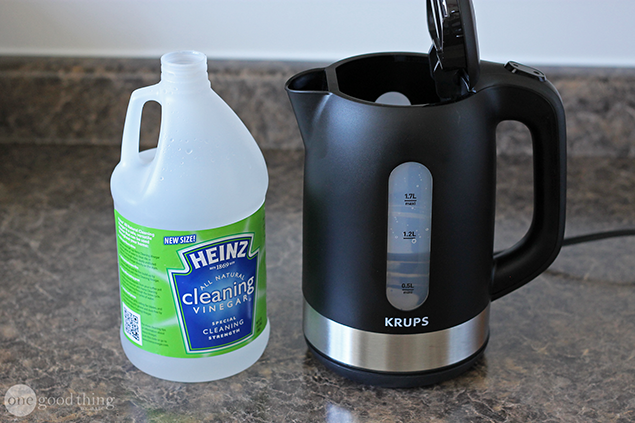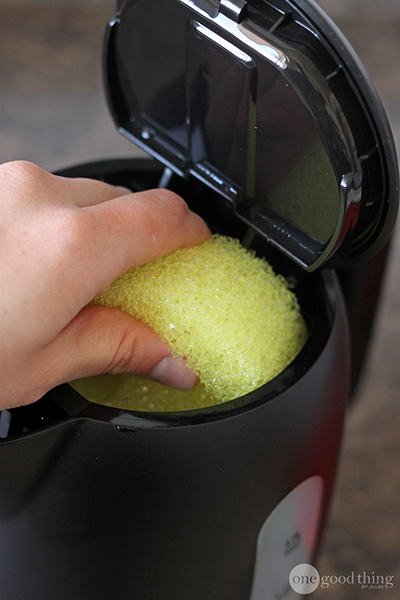how to clean electric kettle

Electric kettles have become incredibly popular because they can boil water for a cup of coffee or tea in a fraction of the time that a stove-top kettle can. They are even considered more efficient than using a microwave for the simple task of boiling water. But this humble workhorse in the kitchen is often overlooked when it comes to cleaning.
It is very important to regularly clean appliances in your home that use water, especially if you live in an area with hard water, like I do! Limescale and other mineral deposits can build up inside your appliances over time affecting their performance, and even shortening their lifespan. This is especially true for appliances that see daily use, such as electric kettles.
The gunky build-up (called "kettle furring" ewwwwwww!) can really spoil your morning tea or coffee if you find flakes of it floating in your beverage!
So today we're going to show you how easy it is to de-scale, clean, and care for your electric kettle to keep it in good working order for a long time to come!
Vinegar Method

Start by filling your kettle 1/2 to 3/4 full with equal parts water and white vinegar. Bring the kettle to a boil, turn it off (if it doesn't turn off automatically,) and allow the water and vinegar mixture to sit in the kettle for 15 to 20 minutes. Discard the water and vinegar after use.
Citric Acid Method

Fill your kettle halfway with water, and bring it to a boil. Once it has boiled, turn it off and add 1 – 2 tablespoons of citric acid powder to the water. Allow the water and citric acid mixture to sit in the kettle for 15 to 20 minutes, then discard.

After performing your descaling method of choice, you may find that you need a bit of extra scrubbing power to clean those particularly stubborn spots.

Using a soft scrubber pad (I LOVE these Scrub Daddy pads!)…gently scrub the inside of the kettle, and rinse well with fresh water. You can also use the scrubber to clean the exterior of the kettle too, if it needs it.

If your kettle has a filter near the spot like this one does, make sure to rinse it clean often. If you find scale build-up on the filter, simply soak it in a small glass of vinegar for several minutes to loosen the build-up, then use a scrubbing pad to get it clean.

Once the kettle is clean, boil a couple of pots of fresh water, throwing out the water each time, to ensure that no taste is left behind. This step is less important if you're using the citric acid method to de-scale, but you'll definitely want to brew at least a few fresh pots of water if you use the vinegar method – no one wants a cup of vinegar-tasting tea! :-)
Additional Tips
- Avoid leaving leftover water sitting in your kettle after use. This habit increases the number of mineral deposits building up inside. Pour out any leftover water (use it on your plants after cooling) and try to boil only the amount of water you anticipate using to eliminate waste.
- Never immerse an electric kettle in water as it can damage the heating element.
- Clean the kettle exterior at least once a week to keep that shiny, new look.
- Clean and descale the interior of your kettle every few months, depending on your frequency of use. In areas with hard water, kettle cleaning should be tackled more often.
- Try using distilled water to eliminate mineral deposits.
- In addition to brewing tea, you can use a tea kettle to make hot water for oatmeal, instant mashed potatoes, instant soup, hot chocolate and anything else that requires boiled water.
- A clean kettle is a green kettle because it uses less energy and extends the life of your kettle.
how to clean electric kettle
Source: https://www.onegoodthingbyjillee.com/how-to-clean-your-electric-kettle/
Posted by: bainknoted.blogspot.com

0 Response to "how to clean electric kettle"
Post a Comment